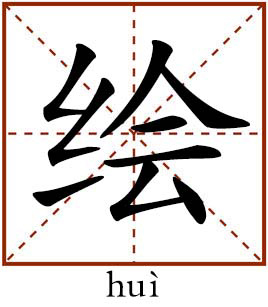drawing

This character refers to drawing pictures. Words containing this character usually include the meaning of drawing or painting, such as ce hui, which means to make drafts, blueprints or maps. Shou hui refers to drawings by a person rather than a machine.
瓷绘
cí huì
Ci refers to “porcelain” and hui means “to draw.” The word, as its characters imply, refers to paintings on porcelain. It is thought that paintings on porcelain were developed in China, perhaps in the Tang Dynasty, when the quality of porcelain had been remarkably improved. By the time of the Song Dynasty, porcelain makers had achieved a high level of skill. Some experts today still consider their work to be unsurpassed in its decoration and design. As the design and decoration of porcelain was constantly refined, innovative techniques such as glazed paintings brought about diverse and exquisite pieces. The Silk Road ensured that they were seen in the Middle East and eventually in Europe.
Floral, abstract or calligraphic designs are often seen on traditional Chinese porcelain. Some of them serve as symbols of good things such as happiness, fortune and fame. For example, the pattern Yi Pin Qing Lian, which is a lotus flower painted on a bottle, symbolizes an honest official, because Yi Ping, which refers to a bottle, has the similar tone as the title of the highest official rank, Yi Pin. Qing Lian, the name of the lotus flower, also has the same tone as the adjective word for being honest or clean. Si Hai Sheng Ping is another traditional design representing a peaceful world. Porcelain with this design usually depicts four kids lifting a bottle together. Si hai, which means “the world,” sounds similar to the Chinese word, “four kids.” “Peace” is pronounced as Sheng Ping, which has the same tone as “to lift a bottle.”
Narrative painting is an important form of porcelain decoration, allowing many ancient civilizations to record and reinforce their cultural beliefs for coming generations. Porcelain makers derived subjects from classic literature or folk tales, painting vivid scenes on porcelain ware, illustrating a combination of aesthetic and cultural values.
